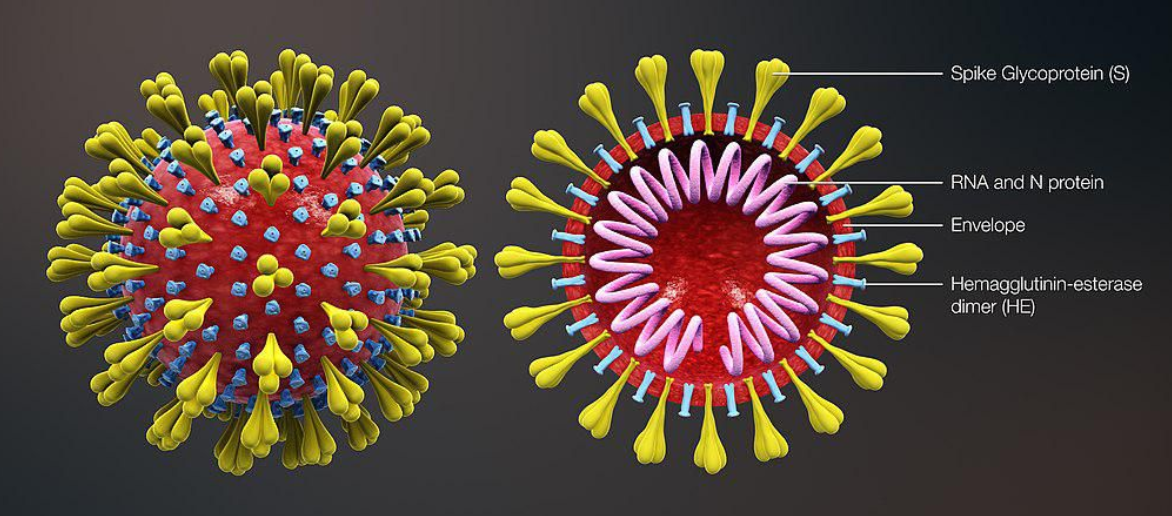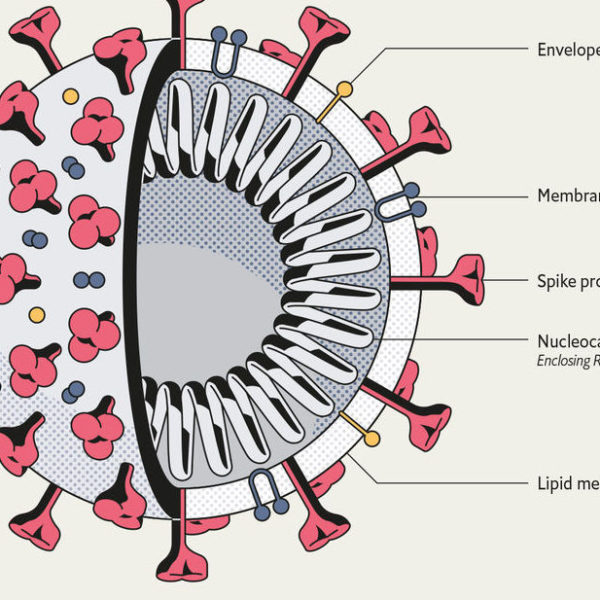
Viruses
by Ryan Lee
As we approach the one-year anniversary of the shutdown of in-person classes at LAUSD due to the COVID-19 pandemic, it seems a meaningful time to reflect on this once-in-a-century event, especially with the newly-increasing availability of effective vaccines. Although the toll that COVID has taken across the country and around the world has been terrible, the speed with which doctors and scientists have been able to develop tests, therapeutics, treatments, and now vaccines has been truly awe-inspiring. As it turns out, viruses have been around since long before 2020, and even the mighty Romans and the undefeatable Mongols have fallen victim to them. In order to better understand this invisible enemy, we need to learn about the structure of viruses themselves and how they infiltrate our body. Since 1892, virologists have dedicated their lives to studying viruses, trying to discover how these mysterious balls of proteins, which lack life itself but can affect so many, can upend our lives so systematically.

The Structure and Description of Viruses
Before we ponder about how viruses infect our bodies, we have to know that there are many different types. Generally, there are four types of viral structures. Many modify themselves to add proteins to their outer shell to facilitate the integration of their genetic material.
Helical Viruses, such as the Tobacco Mosaic Virus, are usually a protein capsid surrounding a single helical RNA molecule. They are the simplest viruses and look like rigid rods. The second type is a polyhedral Virus, typically known to be isohedral. They usually contain DNA in the center of their capsule and are covered in protein spikes. Some examples of these are Adenoviruses.
Spherical Viruses look like small toy balls. They contain RNA-protein complexes and are usually studded with Glycoprotein spikes that enable them to interact with the cell’s recognition and cell-communication mechanisms. They are the most mutatable viruses, as their RNA is susceptible to mutations that may benefit them. Examples of these viruses include Influenza (the flu), HIV, and Covid-19. Finally, Complex viruses are viruses that have multiple parts, consisting of tails, fibers, and a head. They grab ahold of the host with a tail fiber and inject their Genetic Material into the host. This type of virus is usually composed of bacteriophages, viruses that only affect bacteria.
Orthocoronavirinae, of which SARS CoV-2 is a member of, is a subfamily of fairly complex spherical Viruses.The SARS-CoV 2 contains 29 different proteins, including its glycoprotein spikes, which it shares 80% of its amino acids with its predecessor, the SARS (Severe Acute Respiratory Syndrome) virus. SARS CoV-2 and it’s family, the coronaviruses, known as Coronaviradae, are characterized by being RNA viruses and its famous Glycoprotein Spikes. The virus, SARS CoV-2, does not have a binomial taxonomic name so far. The Family is named after the latin word, “Corona”, which translates to “The crown”. The Virus uses its spikes to latch onto the angiotensin-converting Enzyme 2 (ACE2). The other 28 proteins are not very important, as only three of them make up the actual structure of the virus. One group of the other 25 proteins are expressed as two huge polyproteins and then cleaves into 16 smaller proteins, and these proteins help regulate how the proteins of its offspring are made and how it sneaks through its host’s immune system. The Third type of protein is called accessory proteins. They don’t need these proteins to replicate, however they need them to counteract the immune system. Covid-19 is more infectious than its predecessor parent, the SARS virus. SARS CoV-2 is usually called, “The coronavirus”, or “The novel Coronavirus”, however, the latter describes the virus better. SARS CoV-2 is a coronavirus, a family of viruses, includes many mammalian RNA viruses such as Mink coronavirus and Bat coronavirus CDPHE15.

Illustration of SARS-COV2
Glycoprotein (RBD = Receptor
Binding Domain)
The Brief History of Viruses
Humans have always been aware that something has been ruining their precious tobacco crops and caused death. However, they simply did not know why or what sickened them, they assumed it was a bacteria or some other infectious agent.
It wasn’t until 1883 when Adolf Mayer, a German Scientist, discovered the characteristic traits of a virus. Adolf Mayer discovered that he could transmit the ailment by rubbing the sap extracted from the diseased leaves of the tobacco plant onto healthy plants. After unsuccessful searches for an infectious microbe, he determined that it was caused by tiny bacteria. Years later, Dmitri Ivanowsky, a Russian biologist, passed the sap through a filter that was known to remove the smallest bacteria. After an unsuccessful attempt, he determined that there was a smaller bacteria or the toxin made by the bacteria made it through.
Dutch botanist Martinus Beijerinck carried out experiments to show that the filtered agent in the sap can still replicate. He also discovered that the agent would not grow without a host. He is known as the father of Virology because he had voiced the concept of a virus. The Virus became known as the Tobacco Mosaic Virus.

How Viruses Replicate
A virus, which most people know and agree with, enters the cell and spreads its genetic material, overriding the host cell’s machinery and making more cells. This is known as the lytic cycle. Contrariwise, there is another reproductive cycle, and it is called the lysogenic cycle, which is not well known.
The lytic cycle is the reason why we get sick. The virus enters the cell and releases its genetic material. The genetic material then replicates itself for later use and transcribes the genome into mRNA, which is sent to the endomembrane system to create proteins. Somewhere in the cell, the Machinery starts to assemble the proteins and the replicated DNA into new viruses. This process will kill the cell, and replication of DNA may bring about mutations to the virus, making viruses such as the flu resistant to old vaccines.
The lysogenic cycle of the cell is typically characterized by the cell not dying or doing anything. The virus attaches itself to the cell, injects its genome, and simply does not kill the cell. Instead, the genome integrates itself into the cell’s chromosomes and waits for certain factors to burst or not. The cell may divide and produce a population of cells infected with the virus. The genetic material may exit the bacterial chromosome, which can become the point where the lytic or the lysogenic cycle initiates.

Vaccines
Vaccines are a way for us to build immunity to a virus that humans have never encountered before. Before elaborating on the mechanics of immunity, it’s important to understand the basic mechanisms of vaccines. A vaccine is essentially a weakened version of the virus, an enzyme that inhibits the binding of the glycoproteins or receptors of the virus, or just the glycoproteins of the virus. In the immune system, there are three types of immune cells, the B cells, the T cells, and the macrophage. The B cells float around the body, binding to any foreign substance. After it binds to the virus, the B cell releases all of its receptors on its body, leaving the virus floating with the receptor binding to it. The B cell then starts to rapidly undergo mitosis to give rise to a group of cells that create the antigen receptor. The macrophage then comes and eats the virus. The T-cell, on the other hand, roams the circulatory system and keeps an eye out for infected cells. They are covered in receptors that bind to parts of the virus. An infected cell will usually present a piece of the antigen on an MHC molecule, causing the T-cell to bind to it and trigger an immune response. The immune system remembers this virus by using memory B-cells, a cluster of long-lived cells that remain to wait until the next viral infection by the same virus.
Every year, a person has to take a vaccine for the flu, a highly contagious and fast-mutating RNA virus. A new vaccine is made every year for the strains of the virus that are most prevalent. We can create a vaccine for SARS-CoV 2, yet its characteristic of being a notorious RNA virus creates the need for us to monitor its mutations and create a future-proof vaccine. But how is a vaccine made?
Since there are many types of viruses, there are many different types of vaccines. The flu virus, which is a spherical Virus, requires the use of dead viruses to force the body to create antibodies for the specific strain for that year. This is called an inactivated vaccine. Some vaccines, such as chickenpox or mumps virus, use a weakened or normal version of the virus to cause the body to fight the infection. This type of vaccine is called a live-attenuated vaccine. Subunit, recombinant, polysaccharide, and conjugate vaccines are pieces of the virus that trigger strong immune responses that can protect the person from future infections from the virus.
The Coronavirus Vaccine, in simplest terms, is a piece of mRNA that codes for the Glycoproteins on the virus which allows the virus to get into the cell. The mRNA is harmless and a subunit Vaccine. The mRNA gets into a nearby cell and the cell makes the protein. The cell then displays the protein on the MHC molecule, allowing the T-cells to see it and create an immune response. The antibodies are made and the Memory B-cells are ready to release the Antibodies when the cell is invaded again. The RNA Vaccine is particularly effective on the Coronavirus since it poses the least risk to the body and is easy to make.

Conclusion
Although it has been a diabolic time, particularly for those who have lost loved ones to the disease, we are fortunate that our knowledge of viruses and the human body has allowed modern medical science to create vaccines and eradicate diseases much more rapidly than the past. Even just a year ago, we thought the earliest an effective vaccine would be available was 18-24 months, but here we are with not just one, but three vaccines which have been very effective in preventing COVID infections and serious illness. While we will need to continue to be vigilant against the coronavirus and its variants for some time to come, something that looks more like normal life seems to be possible again soon.
Timeline of Events of Coronavirus
Additional information available here: https://www.who.int/news/item/29-06-2020-covidtimeline
Bibliography
Nature News, Nature Publishing Group, https://www.nature.com/scitable/topicpage/the-origins-of-viruses-14398218/.
“COVID-19 Vaccine Tracker.” Regulatory Affairs Professionals Society (RAPS), https://www.raps.org/news-and-articles/news-articles/2020/3/covid-19-vaccine-tracker.
“Different COVID-19 Vaccines.” Centers for Disease Control and Prevention, Centers for Disease Control and Prevention, https://www.cdc.gov/coronavirus/2019-ncov/vaccines/different-vaccines.html.
“Digital Collections – National Library of Medicine.” U.S. National Library of Medicine, National Institutes of Health, https://collections.nlm.nih.gov/bookviewer?PID=nlm:nlmuid-2569009R-bk#page/46/mode/2up.
“Immunization Basics.” Centers for Disease Control and Prevention, Centers for Disease Control and Prevention, 16 May 2018, https://www.cdc.gov/vaccines/vac-gen/imz-basics.htm.
Jarus, Owen. “20 Of the Worst Epidemics and Pandemics in History.” LiveScience, Purch, 20 Mar. 2020, https://www.livescience.com/worst-epidemics-and-pandemics-in-history.html.
“Outbreak: 10 of the Worst Pandemics in History By Staff.” Outbreak: 10 of the Worst Pandemics in History, https://www.mphonline.org/worst-pandemics-in-history/.
Santora, Tara. “2020-2021 Flu Shot Ingredients: What Is in the Flu Shot, and Why?” Fatherly, 14 Jan. 2021, https://www.fatherly.com/health-science/flu-shot-ingredients-flu-vaccine/.
“Understanding MRNA COVID-19 Vaccines.” Centers for Disease Control and Prevention, Centers for Disease Control and Prevention, https://www.cdc.gov/coronavirus/2019-ncov/vaccines/different-vaccines/mrna.html.
“Vaccine Types.” Vaccines, https://www.vaccines.gov/basics/types.
“Variola Virus (Smallpox).” Johns Hopkins Center for Health Security, https://www.centerforhealthsecurity.org/our-work/publications/smallpox-fact-sheet.
“View of Andrew Brown’s ‘Earnest Endeavor’: The Federal Gazette’s Role in Philadelphia’s Yellow Fever Epidemic of 1793: Pennsylvania Magazine of History and Biography.” View of Andrew Brown’s “Earnest Endeavor”: The Federal Gazette’s Role in Philadelphia’s Yellow Fever Epidemic of 1793 | Pennsylvania Magazine of History and Biography, https://journals.psu.edu/pmhb/article/view/45107/44828.




